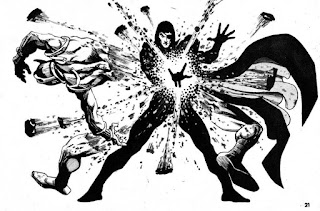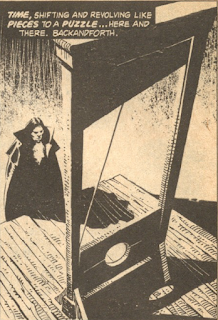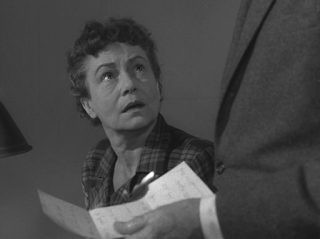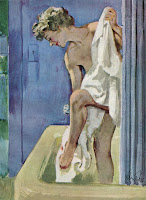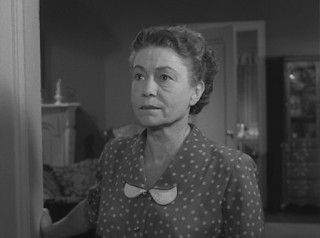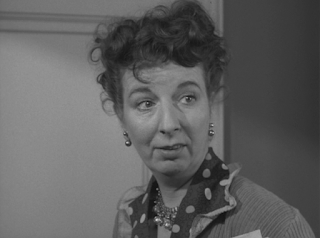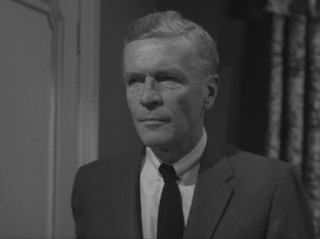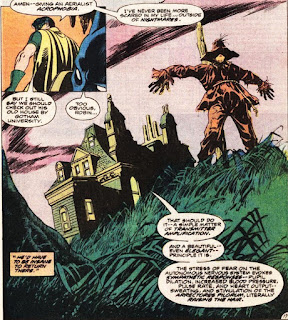The Critical Guide to
the Warren Illustrated Magazines
1964-1983
by Uncle Jack
& Cousin Peter
 |
| Kelly |
Eerie #80
"The Invisible One"★★★
Story by Budd Lewis
Art by Jose Ortiz
"Retribution"★★1/2
Story & Art by Jim Starlin
"On Moonlight Bay"★★
Story by Budd Lewis
Art by Leopold Sanchez
"Pieces of Hate"★1/2
Story by Gerry Boudreau
Art by Gonzalo Mayo
"Third Person Singular Part II"★★
Story by Bruce Jones
Art by Luis Bermejo
"Queen of the Purple Range"★★
Story by Nicola Cuti
Art by Carmine Infantino & Al Milgrom
After Japan opened up to foreigners in 1854, attacks on foreign ships became commonplace as former samurai roamed the country without masters. When an Irish "Scallywag" appears on the docks, several ronin attack him, only to discover that he is handy with Ben Wa balls and can throw them with enough speed and accuracy to kill. One samurai, Konishi, remains calm and agrees to join the Irishman, Hues "Sully" Sullivan, on his Chinese junk, where beautiful girls await with trays laden with food. That night, as Konishi and Sully sleep, a ninja, "The Invisible One," steals aboard the vessel, butchers crew members, and steals a cursed statue and some jewels. Sully vows revenge.
The first entry in the "Scallywag" series is intriguing, with a good evocation of the place and time and the usual fine art by Ortiz. I'm interested in mid-nineteenth century Japan and I'd like to see where this goes.
Darklon's severed head is placed on an altar and he is shown all sorts of freaky stuff. He awakens, having been through black baptism and rebirth, only to learn that he is now owned by the Nameless One. Prince Darklon has been transformed into Darklon the Mystic and, as such, he heads to the capital city of Nebularia, where he gains "Retribution" by killing Blacklore's minions and then blowing Blacklore to pieces. Darklon frees his captive father and renounces any claim to his throne. In the present, he wonders if his father sent the assassins who have been bothering him.
The art is classic Starlin, but as I stifled a yawn while reading this entry in the Darklon saga. I had to wonder if my awe at Starlin's work back in the mid-1970s, when I was a teenager, was due more to my youth than to anything terribly exciting in the presentation. So far, Darklon seems kind of predictable.
Al Greene ("Owl") and Eric Plusenkat ("Pussycat") have survived nuclear war and now sail their vessel toward Greenland, uncertain if anyone else remains alive. They are fired on as they approach port and, after Al is shot in the leg, Eric returns fire. The duo go ashore and meet a group of people who fear a monster that comes every night and steals a sleeping child. That night, Owl and Pussycat discover a "monster" on a sailboat; the creature turns out to be a man who suffers the physical and mental effects of radiation poisoning. Eric volunteers to put the creature out of his misery and he and Al sail off for the next port.
This series is depressing. The world has been destroyed by nuclear war, so a couple of guys who survived sail around and find that things are as expected. The art is shaky, hardly Sanchez's best work, and the "monster" is almost more humorous than frightening. I suspect Budd Lewis will drag this out for a while longer and teach us lessons about violence and tolerance.
In 1992, nuclear war has wiped out much of Earth's population. What's left of the human race has returned to savagery and hunting game to survive. There is also a growing number of vampires, who orbit the Earth in a spaceship in between biting necks down below. The vampires discover a third group made up of members of an international cartel that controlled wealth and still has nuclear weapons; they destroyed the world out of boredom. For sport, the cartel members challenge the vampires to a game of hunting, to see who survives.
Gerry Boudreau's "Pieces of Hate" is a jumble of old ideas, cribbing from "Arena," The Most Dangerous Game, Planet of the Vampires, and who knows what else. The story takes time to get going and then just ends, presumably setting this up as another series called "Tombspawn." Mayo's art recalls that of Maroto; in some places, it looks great, while in others, it looks unfinished. He manages to shoehorn in a few panels of beautiful, scantily clad women for no particular reason.

Having discovered that the Snuffer who attacked him is a woman, Rick lets her escape and she promises to repay him someday. Rick and Lee visit the library and discover a subterranean room filled with rare books, including a sex manual written by a woman over 800 years ago. A Snuffer bursts in but, luckily for Rick, it's the gal who owes him a favor. Rick explains that he likes girls and, before you know it, he and the Snuffer are rolling on the floor, with no Kiss records in sight. The Snuffer, whose name is Laura, takes Rick to the hidden world of women, where Old Greida, the commune leader, explains how they reproduce, though the details were lost on this reader. Suddenly, Snuffers burst onto the scene and attack the women; Rick and Laura escape through a secret tunnel and survive, though Laura seems to have lost her clothes in the fracas.
We'll have to give Bruce Jones a pass on this silliness, which is the sequel to last issue's story. Bermejo's art isn't bad, though he seems to be imitating Jack Davis in the way he portrays Old Greida. The scene where Rick convinces Laura that she really does have the hots for him is unintentionally hilarious: "...but you've wanted to, haven't you? You've thought about it for years... dreamed about it at night... tossed and turned and awakened hot with restless sweat, the way I have..." Hoo boy, Rick, if that line works, I should have tried it long ago.
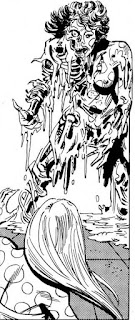
Cronk, the Satyrian Devilboar last seen in Eerie #77, has been hired to deliver six eggs to a Gagoian colony, but one of the eggs hatches early and out pops a sexy "Queen of the Purple Range." Cronk is more in need of a mechanic than a girlfriend, so he sticks her in the navigator's chair and hopes for the best. When Cronk has to venture outside the spaceship for a repair, another queen stalks the navigator, who makes short work of her. Cronk teaches the queen how to fix the ship and, when they land on Gagos, he has to forfeit his money, since she's now more grease monkey than royalty.
Al Milgrom's inks make this story look like classic 1960s' Infantino, and the Gagoian queen is depicted surprisingly well. Cuti's script has plenty of humor and, though the story is nothing special, at least it's a pleasant way to pass eight pages at the end of a half-decent issue of Eerie.-Jack
 |
| The Pussycat flexes his claws |
Peter-Devoid of anything resembling fantasy or horror, "Scallywag" is definitely a stretch for the kind of series that should appear in
Eerie. Thank goodness DuBay was out to lunch when this series was okayed (or else it would have been retitled "Scallywag and the Infinitesimal Junks of Samurai Swag," or something idiotic like that. I'm not sure how the remaining four chapters of "Scallywag" will turn out, but the opener is just what the doctor ordered: exciting and enthralling, with some great graphics.
Darklon still looks great but, more than ever, it reads like Stan Lee was moonlighting ("Your old body was too frail to house the awesome soul-searing might I have granted you!"). The panel designs Starlin throws at us are awesome and soul-searing! I will say that the series does feel more at home in this title than does Scallywag. The saga of Al and Plusenkat ("The Owl and the Pussycat"--oh my god, that kills me every time--what are the chances two guys with names like that would team up?) continues with a part two that doesn't measure up to the initial outing. Pretty tame, cliched stuff. Nuclear-mutated menace? Check. Frightened survivalists? Check. The scene where the optimist has enough and starts blowing away anyone in his sights? Oh yeah, that's definitely there.
"Tombspawn" is an unnecessarily complicated bore, stuffed full of lame cultural references that make it seem much more dated than it should be. When all is said and done, most of these post-apocalyptic extravaganzas follow the same dopey rules. "Tombspawn" just adds vampires. Neither "Third Person Singular Part II" nor "Cronk" did a thing for me. "Cronk," even more than "Darklon," reads like a bad Marvel try-out. Neither will see another chapter (which is weird, since "Third" seems to end in the middle of the story... but I won't complain).
 |
| Enrich |
Vampirella #57
"City of Ghosts"★★
Story by Roger McKenzie
Art by Jose Gonzalez
"Rusty Bucklers"★1/2
Story by Bruce Jones
Art by Esteban Maroto
"Stand-In"★★
Story by Bruce Jones
Art by Carmine Infantino & Dick Giordano
"Magnificent Ephemeral"★★
Story by Bruce Jones
Art by Ramon Torrents
"An Insult to Science"★★
Story by Fernando Fernandez
Art by Jose Mirales
As Adam van Helsing drives a jeep through the New Mexico desert, with Vampirella riding shotgun and Pendragon hiccupping in the back seat, a stagecoach suddenly crosses their path and they crash. Vampi wakes up alone and finds Tristan, her old lover from Drakulon, unexpectedly at her side and also the sheriff of an Old West town. Adam appears and loses a shootout with Tristan; Pendragon turns up as a talking skull, seated at a bar. Vampi realizes it's not real and turns into a bat to escape before waking up to find Adam and Pendragon alive and well.
"City of Ghosts" is as old (and dumb) as they come, with Vampi hitting her head and having a fantasy before returning to consciousness and reality. Fortunately, the art by Jose Gonzalez is terrific, some of the best we've seen in quite a while from him. He throws in a couple of panels that look like copies from photos (who was the model?), which more than make up for the unintentionally hilarious panel of Adam as a desperado/mid-'70s member of The Eagles.
An old man named Dete welcomes a young knight, who rides up and announces that he plans to free the maiden Charlot from the clutches of the sorcerer Nieche. Dete hops on his old nag and accompanies the knight on his quest. The knight defeats an ogre and reaches the home of the legendary fire lizard, but the lizard has died and is now a pile of bones. When they reach Charlot, they find her middle-aged and overweight, and her captor has been dead for years. Dete meets Charlot in the stable for a naked romp, but when the knight discovers them, he runs Dete through with his sword for compromising the lady's honor. She tells the knight to ride off and rescue someone else because she's too old and set in her ways to accompany him.

Yawn. Eight pages of pretty pictures from Maroto can't fix this tired script, and it's all been done before, over and over again. The modern take on the knight's quest is so old by now in the pages of a Warren mag that I kept looking for a new twist, but it was all in vain. The only surprise was the somewhat chunky heroine, an unusual approach for a woman in a Maroto story. Even then, she's still pretty attractive, which probably is not what Bruce Jones intended when he wrote "Rusty Bucklers." The title is probably the cleverest thing about this one.

In the future, one can predict exactly when and how someone is going to die in an accident, and McHenry, a representative of Surgo, Inc., can be hired as a surrogate for the person about to die. He replaces them just before the accident and does his best to survive. If he lives, he gets $10,000 and the other person is put to death. If he dies, the other person lives. He makes it through a terrible car crash and collects his money; a child will be put to death instead. A reporter named Ms. Reynolds is disgusted by the practice and by McHenry, who next survives a house fire that would have killed a little girl, who turns out to be the daughter of Ms. Reynolds. Romance blooms but is soon finished when McHenry takes Ms. Reynolds's place in an accident; he appears to die and leaves her his insurance money, which is enough for her to travel to Earth. But wait! McHenry is alive and well and meets back up with Ms. Reynolds once she has reached Earth, with the insurance company none the wiser.
The team of Infantino and Giordano produce smooth art, but it's not enough to iron out the wrinkles in this needlessly over-complicated story. "Stand-In" doesn't make a whole lot of sense. If McHenry survives, that means Miss Reynolds's daughter is put to death. After that, she's willing to get romantic with him? The business with him faking his own death is a bit confusing, as well.
The 1948 diary of reporter Scott Westly tells of his search for movie star Gloria Winsome, who seduced all of Hollywood with her beauty and then disappeared after making but a single film, "Magnificent Ephemeral." Scott goes from person to person and place to place, looking for the elusive star, and finally tracks her down, living alone in a mansion with a butler. When Gloria screens her famous nude scene for Scott, he discovers the truth--she's a man! She hands him a knife and asks him to put her out of her misery.
The first two pages of this story suggest that, after Scott killed Gloria, he hung himself. Who can blame him? The story goes on way too long and mixes together bits and pieces from various old Hollywood movie plots, but the main thing I thought of at the end was Austin Powers remarking, "It's a man, baby!" Ramon Torrents has become one of my least favorite of the regular Warren artists, mainly due to what seem like numerous photo swipes, and twelve pages of his work is more than I'd like to see in any one issue.

Ghost-breaker Dr. William Miller attends a seance, intending to expose it as nonsense, but receives an unexpected message telling him not to go to Boston or else he'll be part of a haunting. Undaunted, he heads for Boston, but on the way he meets a beautiful woman in the woods. She thinks he's her lover and tells him that she must hurry home to her husband, Edward. William subsequently gets lost and seeks shelter at a creepy old house, only to find the same woman there. She claims to be dying and to fear her jealous husband. William takes advantage of the situation and embraces her, but before they can consummate their passion, Edward strangles and kills his wife. William shoots Edward, who falls through a window to his death.
William goes to the police, only to learn that the woman's house is in ruins and he was part of an annual reenactment by spirits of events a quarter century before. He journeys on to Boston, where he addresses other scientists and admits that the spirit world does exist.
"An Insult to Science" is a competent version of a story told many times before, with stilted but nice-looking art by Mirales. As Peter points out below, he relies on stills quite a bit; in one panel, a character is a dead ringer for Peter Cushing.-Jack
Peter-It was all a dream! A really well-illustrated dream, but a dream, nonetheless. I think we can all agree at this point that the Vampirella feature each issue would be better represented by pin-ups rather than an attempted stab at cohesion. Leave it to Bruce Jones to take sword and sorcery, a genre literally impaled by Warren writers, and make something interesting of it. Though "Rusty Bucklers" doesn't end with a big surprise, it does go out with a smile.
"Stand-In" is a bit confusing in its rulemaking (so McHenry can put on a crash suit when he climbs in the car but not flame-retardant gear for the fire?), and Glenda's recovery from her kid's death is quite speedy, but I thought it was clever enough for a few minutes' distraction. Carmine's really getting into a groove and it seems the editorial staff knows just what type of material to use his talents on. The third Jones vehicle this issue is the best one, a goofy homage to Sunset Boulevard and Laura, delivered with a wink that you'll either love or hate. I loved it, although I'll admit the running time is a bit long. As is the page count for "An Insult to Science," an okay Gothic ghost story that features the one and only appearance by artist Jose Mirales, whose work, like a lot of the Spanish artists in the Warren pubs, draws heavily on stills. One of the better issues of Vampirella in quite a while.
 |
| Kelly |
Creepy #85
"Like Icarus, Quickly Falling" ★1/2
Story by Roger McKenzie
Art by Leopold Sanchez
"Hide and Go Mad" ★★1/2
Story by Budd Lewis
Art by Carmine Infantino & Walt Simonson
"The Thing in the Well" ★★★
Story by Roger McKenzie
Art by Leopoldo Duranona
"Orem Ain't Got No Head Cheese!" ★
Story by Bill DuBay
Art by Jose Ortiz
"The Terrible Turnip of Turpin County" ★★1/2
Story by Roger McKenzie
Art by Martin Salvador
"A Way in the Woods" ★★1/2
Story by Bruce Jones
Art by Luis Bermejo
An All-Monster Issue? Count me in! But how well will the Warren writers represent the monster kingdom? Let's see.
A vampire tracks the man who made him into a bloodsucker across the centuries, finally finding him in a post-apocalyptic future. He beheads the demon and then flies out to sea and is reduced to bones by the sun. A wordy, pretentious mess (And like Icarus, quickly falling, time rushes back upon itself... spinning and tumbling out of control.), "Like Icarus, Quickly Falling" makes little sense, jumping back and forth between its time frames. McKenzie makes it (abundantly!) clear that the opening is set in the future, but the Armageddon side of things is just quickly mentioned and not really explained. Everyone on Earth is dead except for these two vampires. Why wouldn't the multitude of blasts (described by McKenzie as "exploding suns") vaporize these bloodsuckers as well? The continual time-jumps are mind-frazzling and McKenzie's adjective-stuffed captions are a real chore to wade through. Icarus didn't fall fast enough for me.
Television actor Oliver Munday climbs the treacherous Mt. Kula Kangri in search of the elusive Yeti. Munday has made it his personal mission to come back to civilization with a snowman pelt to prove he's just as much a man as the stud he portrays on his TV show. The weather turns violent halfway up the mountain and Munday leaves his guides behind, only to come face-to-face with the giant monster shortly after. He takes a shot at the thing, but the rifle's roar sets off an avalanche and Munday is buried.
Digging himself out, Munday is lucky to be alive, but certain death stands looking down on him in the person of the great white Yeti. A bullet fells the creature and Munday steals its hide. As he's making his way down the mountain, he puts the skin on for warmth, but the blizzard is too much for him. Suddenly, the skinned monster appears from out of the snow. Munday tries to give the thing back its hide, but the pelt has frozen itself to his body. Later, the two guides come across the skinned Munday and agree that the actor went insane and tore himself to ribbons.
Nothing spectacular script-wise (I think I read at least three Harvey stories that followed much the same pattern), but "Hide and Go Mad" is an entertaining EC-esque horror story with some decent (though, at times, way too light) art by Carmine and Walt. I'm a sucker for stranded explorers atop giant glaciers; though I'm not the kind to ever get caught in that situation (hello, I live in Arizona!), the whole scenario gives me the creeps. I would question why this monster would lie still while Munday stole its skin.
Young Nancy has been lonely since her mother left the little shack she lives in with her stepfather. But now she has a friend she can talk to who lives in the well out in the woods. Nancy has vague recollections of the night her mother disappeared: a fight, the sound of something hitting the floor, and then her stepfather carrying something out into the woods. Her stepfather beats her and tells her to stay away from the well; it's not safe. But being lonely outweighs being afraid of the violent drunk her mother was married to, so Nancy steals away one night at the same time her step-pop decides to board up the old well. Seeing Nancy leaning into the well, the man hits her in the head with a hammer, but before she dies, the girl sees "The Thing in the Well" rise one more time to comfort her dying daughter.

Though it has DNA lifted from several sources (chief being Theodore Sturgeon's "It!"), "The Thing in the Well" goes where I least expected it to go. That's a pretty downbeat climax; step-pop doesn't even get disemboweled or turned into a human well or anything so final. He's driven insane by the sight of his wife's moss-laden body, and that's our final glimpse of the bad dude. While, conversely, the truly sympathetic Nancy has her head beaten in. How depressing is that? The final panel, of mom and daughter reunited in death, is a powerful one.
Orem P. Boozer the Third and his purty cousin, Honey Gal, hunt the woods near their shack for poachers. When they run across the varmints, they blow them away, skin them, and use 'em as vittles. But unfortunately, Orem's latest kill had brain cancer, and the disease fuses together the leftovers from Orem's past kills to become a huge, globby-brained monster. After the creature attacks Honey Gal, Orem chases it off and muses that once them "city slickers" see the monster crawling out of the hills, they won't be comin' back to poach.
With the new wave of violent horror films cashing in at the box office, Bill DuBay sees a quick and convenient way of capitalizing on the trend. Bill must have watched Texas Chainsaw Massacre and come away thinking cannibals were cool, rather than recognizing the reason the film worked: tension and terror. Neither asset can be found in "Orem Ain't Got No Head Cheese," a vile, disposable piece of garbage. No doubt the centerpiece, Orem and Honey Gal discussing changing times for rednecks while butchering a naked woman, is DuBay's idea of depth in character. I defy Louise Jones (Simonson) to find relevance, insight, terror, or tension in these nine sheets of used toilet paper; what justification could Louise have had in running this thing? "Orem" ain't sly enough to be social commentary, so don't go grasping for that straw. Easily, the worst thing Warren has run in its 13 years of funny book publishing. Alas, that milestone might still be surpassed in the next six years.
A comet falls from the sky and lands in Charlie Smithers's wheat field. The next day up pops a giant vegetable. Charlie insists the thing is a turnip, but the growth has a life of its own. Digging into the ground, the thing gets its rooty tendrils around the corpse of Nate Sweeney, buried in a nearby cemetery. Nate rises from the grave and attacks farmer Smithers and his wife, and the couple become animated corpses just like Charlie. Marcus and Sam, Charlie's friends from town, come to investigate the new vegetation, but when they get to the farm, they discover the land has been overrun with the giant green monsters. Sam is killed and revegetated but, luckily for Marcus, help arrives in the form of a swarm of locust. "The Terrible Turnip of Turpin County" is no more.
Unlike the previous story, I accept "Turnip" as, simultaneously, a loving homage to and a parody of such cinema classics as Night of the Living Dead, Little Shoppe of Horrors, and Invasion of the Body Snatchers. There's a goofiness to its die-revive repetition and its naive climax, where this insanely robust locust swarm wipes out an entire farmland in three minutes flat. A pity it has to come wrapped in a lifeless Martin Salvador package.
Richard Connors crashes his small plane in the Canadian wilderness and attempts to survive with no food or water. He feels the presence of someone in the woods and follows the shape to a cave surrounded by a lake filled with clean drinking water. Later, the shape makes itself visible to Richard in the form of the beautiful Shara. The two quickly fall in love, but Shara has some dangerous secrets that threaten to tear the couple apart. One of those secrets is a bond with a wolf named Falla. The wolf injures Shara and Richard kills the beast, receiving a bite in the process. Shara explains the rest of her secret to her new lover and the two transform into wolves, loping off into the forest to hunt.
A very simple, predictable fable but a sweet one, nonetheless. "A Way in the Woods" is hampered a bit by some dopey dialogue ("I've been watching your eyes, Richard. I know you've thought of making love to me!") but it's blissfully free of expository and Bermejo's rough sketches have never been more gorgeous.-Peter
Jack-Peter, you went pretty easy on this dreadful issue of Creepy. "Hide and Go Mad" is the best of the lot, with an engaging story, an unexpected ending, and above-average art. "A Way in the Woods" is next, with more decent art that reminded me in spots of the work of Berni Wrightson; I wasn't exactly sure what happened in the story, but I'll take your word for it. The muddy art made "The Thing in the Well" hard to decipher and, unfortunately, the panels that were most clear were ugly. Haven't we had enough muck monsters? Apparently not, since "Orem" and his head cheese presents us with another one right away. I agree that the story is disgusting, but I can't give it one star with art by Ortiz, and I don't think it's anywhere near the worst thing we've read at Warren.
As if this issue weren't bad enough, we have to endure a Martin Salvador story about a sentient turnip? At least the zombies were pretty well done. For me, "Like Icarus" was worse than "Orem" and received a rare, one-star rating. This terrible, pretentious, confused mess features mediocre art and an inscrutable story. I'm glad you were the one who had to figure it out to write a summary!
 |
| Corben |
Comix International #5
"Bowser"
"The Succubus Stone"
"The Corpse with the Missing Mind"
"...And an End"
"Deja Vu"
"Demons of Father Pain"
"The Origin of the Spirit"
"In Deep"
Jim Warren's overpriced experiment in overkill comes to an end after five full-color issues. "In Deep" is presented sans its black and white intro page and its outro gets a weird red and white finish on the inside back cover. That's class. To add insult to injury for the unwary buyer, the final Mummy story, "...And an End," had just been reprinted a few months before in the All-Mummy Reprint issue of Eerie. Albeit the new version is colorized (as is "The Corpse with the Missing Mind"), but that doesn't make the triple dip any better. Warren's pilferage of his own funny books would worsen as time went by. The only difference between Comix International and the titles that followed it is that CI looked classy.-Peter
Jack-How in the world did they decide which stories to put in these issues? "Bowser" is good and "In Deep" is great, but most of the others are nothing special, except for the Spirit story (of course) and "Demons of Father Pain," which I liked the first time around. The price of $2.99 was steep back in 1977 (at least for me, as a teen) and I would've wanted something more than what we get here to part with that kind of money.
 |
Next Week...
Doug Moench puts another rogue
in his toybox! |






